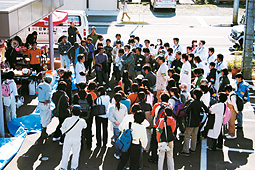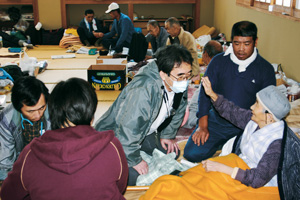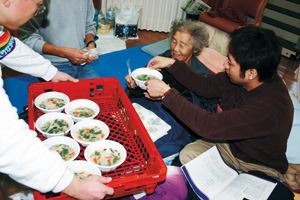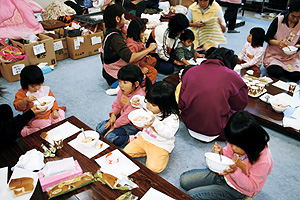MIN-REN SENDS MEDICAL STAFFS TO THE DISASTRES.
1. Powerful earthquakes hit at Chuetsu districts in Niigata prefecture, north east Japan, facing the Sea of Japan, about 300 km from Tokyo at the five o’clock of Saturday October 23.
 Min-iren sent quickly their contingents including medical staffs. Based on the clinic of the Nagaoka Health care cooperative in Nagaoka city, where one of the biggest disaster places of this time, many staffs coming from various Min-iren institutions nationwide began to work for the community people in the ruined towns and villages.
Min-iren sent quickly their contingents including medical staffs. Based on the clinic of the Nagaoka Health care cooperative in Nagaoka city, where one of the biggest disaster places of this time, many staffs coming from various Min-iren institutions nationwide began to work for the community people in the ruined towns and villages.
Mr.Hiroyuki, SAKAI, staff of central management department of Saitama Health care cooperative Hospital, who came to engage help campaign, said,
 |
 |
“At nine in the next morning after the earthquakes occurred, we started to drive our cars from our Saitama Hospital, located near Tokyo, to Nagaoka city, loading with a lot of emergency food and medical materials we have stocked. On the way, we saw several unordinary scenes such as naked roads destroyed and sunk by temblors, and broken signals on the corner of the streets. Fortunately, Nagaoka clinic was not ruined and their basic functions such as electricity, potable water and telephone line were alive. There was already over 60 evacuees settled in the clinic and the attached the aged person’s residence. We entered the communities destroyed the next day with other counterparts from Min-iren. We walk around the neighborhoods to recommend for residents and evacuees who lack food and care, to come to our clinic”.
Since the big temblors have continued after the Earthquake, residents in town or village communities can not design their reconstructing life plan. Some people died caused by stress and bad health condition in the public shelter or in the vehicle where they were obliged to live in after the quake.
Dr. Kozo Ueda, president of the Kobe Cooperative Hospital pointed out, referring lessons from the Hanshin Great Earthquake in 1995 which killed 6000 people and made over 80000 evacuees,
“We are afraid that elderly persons often have arteriosclerosis. When they received even smaller stress in such disaster, they will easily have in blood clot, bleeding or cerebral infraction. So, it is better to remove them from public facilities such as gymnasium and community centers from medical and health care facilities such as clinics and care residences”.
2. Visiting health care campaign in the typhoon flooded districts.
 Typhoon named No.23 attacked Hoygo prefecture, near Osaka October 20 and the Maruyama River collapsed and overflowed into the communities attaining at over one meter high of house wall. Roppou clinic belonged to Tajima Health care cooperative also damaged first floor by the flood and found all of the medical facilities and electric goods were not work. However October 24, two days after the attack of Typhoon, Roppou clinic started their health care services, with building a tentative diagnostic room, and moreover within the next two days interval, the clinic recovered their ordinary service condition including visiting medical and care services.
Typhoon named No.23 attacked Hoygo prefecture, near Osaka October 20 and the Maruyama River collapsed and overflowed into the communities attaining at over one meter high of house wall. Roppou clinic belonged to Tajima Health care cooperative also damaged first floor by the flood and found all of the medical facilities and electric goods were not work. However October 24, two days after the attack of Typhoon, Roppou clinic started their health care services, with building a tentative diagnostic room, and moreover within the next two days interval, the clinic recovered their ordinary service condition including visiting medical and care services.
So many victims houses still can not being cleaned up due to heavy distracted materials in the home, evacuees were compelled to live uneasy in the public facilities or special shelters.
Min-iren staff astonished to find among the evacuees in the community who attained high blood pressure over 200 mm. Staffs sent them by vehicle for the clinic and gave them drip infection and even meal service, then brought them back their resident place.
One of the great troubles in the disaster places is cleaning up both in and out of the houses submerged.
XXX
- 記事関連ワード





